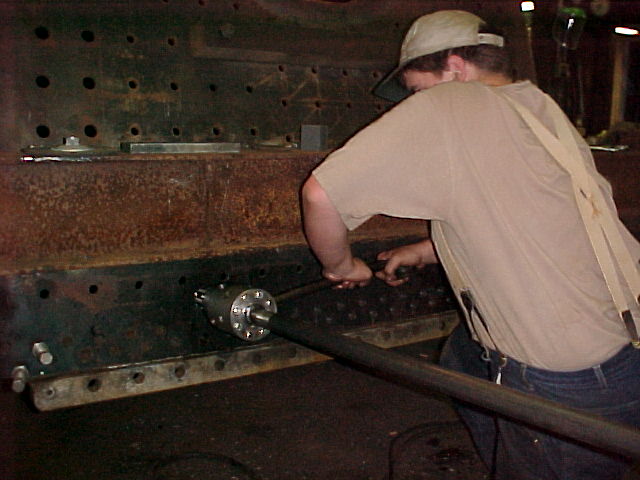

Tender
SP&S #273
Astoria RR
Work Photos
Early Photos
History
Events
Join
ARPA
Links
Contact Us
Home
|
|
|
Tapping Washout Plug Holes
Thursday, August 22, 2002 by Martin AdamsThere are four washout holes, located just above the mudring in the new section of the backhead (There are 15 or so of these holes throughout the entire boiler). Their purpose is to allow access to the inside of the boiler at strategic locations so that the sediment that accumulates there can be washed out. If the sediment were allowed to accumulate, it would insulate the steel from the water and without the water contact the heat from the fire in the boiler would “burn” or weaken the steel sheets and tubes. We made the special tap holder that you see in the picture with its six foot long extension (tail) to keep the tap straight while the tap is turned to thread the holes. We rest the tail end in a “vee” cut into a 4x4 atop a stack of cribbing and have someone apply their weight to hold it in place. The tap is then turned by inserting a spud wrench into one of the six holes around the periphery of the tool. This way, no matter how much force is needed to turn the tap, and it is considerable, the axis of the tap remains perpendicular to the plate and we create a nice, steam tight, threaded hole for the washout plug. It is interesting to note that washout plugs came in various sizes, numbered from #1 to #6. They all have the same 1 ½ inch taper per foot and the same 12 threads per inch. The diameter of each size slightly overlaps the next size so if you ding up the threads with your washout hose, or if the threads get worn and the plug leaks you can just run a tap in a little further and re-cut the threads a little deeper. When the plug that you are using finally gets to the point of screwing too deep into the hole, you just get the next size larger plug. This one will seat on the first part of its threads in the same hole. This is unlike pipe thread which use a different thread per inch for different sizes and would require a new hole and a whole new set of threads for a larger plug. Those railroad guys really knew how to build things that were repairable..
More Photo NEWS
